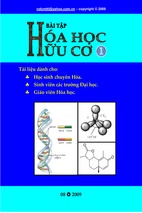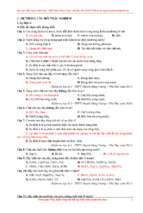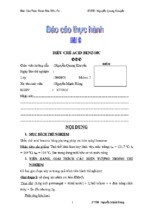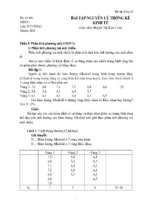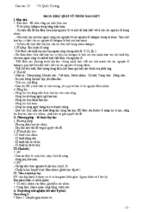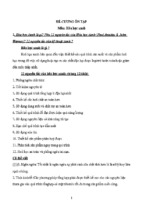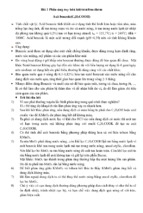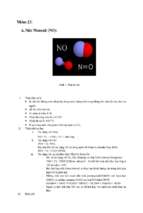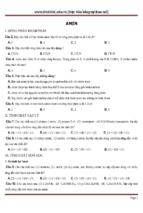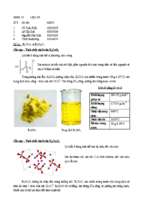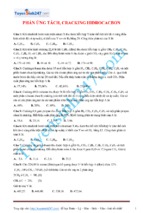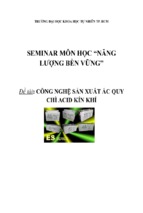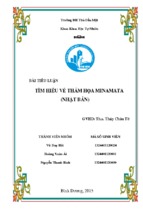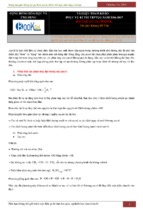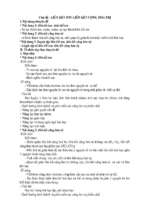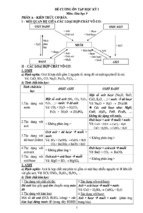Mô tả:
M. Vable
Mechanics of Materials: Review
REVIEW
Stress
• Stress on a surface is an internal distributed force system.
• The relationship of external forces (and moments) to internal forces and the relationship of internal forces and moments to the
stress distribution are two ditinct ideas.
Stress at a point:
---- Is an internal quantity.
---- Needs two directions and a magnitude to specify it.(2nd order tensor).
---- Stress is a symmetric tensor.
---- Has units of force per unit area.
---- Sign is determined by the direction of the internal force and the direction of the outward normal of the imaginary cut
surface.
Outward normal
i
Internal Force
σ ij =
ΔAi
Printed from: http://www.me.mtu.edu/~mavable/MoM2nd.htm
ΔFj
direction of
outward normal to the
imaginary cut surface.
⎛ ΔF j ⎞
lim ⎜ ---------⎟
ΔA i → 0⎝ ΔA i⎠
direction of the
internal force component.
Stresses on various planes passing through a point in two dimension can be found by the:
---- Wedge method (equilibrium method). --- Convert stresses to forces and use equilibrium equations to determine the
unknowns.
---- Mohr's circle.----A point on the circle represents a unique plane and the co-ordinates of the point represent the normal
and shear stress on the plane.
Prefixes on stress: Normal stress, Shear stress, Principal stress, Maximum shear stress, Maximum in-plane shear stress, axial
stress, flextural stresses, torsional shearing stress, maximum normal stress, yield stress, ultimate stress etc.
August 2012
1
M. Vable
Mechanics of Materials: Review
Strain
• Measure of relative movement of two points on the body. (deformation).
• Elongations are positive normal strains.
• Decrease from right angle results in positive shear strains.
• Small Strain (< 0.01) approximation simplifies calculations.
• In small strain In normal small strain, the deformation in the orignal direction only is required.
Strain at a point:
---- Needs magnitude and two direction to specify it.
---- Tensor normal strain=Engineering normal strain; Tensor shear strain=Engineering shear strain/2;
Is related to the first partial derivative of deformation. (3) Strain is a symmetric tensor. In 3-D: 6 components are needed to specify
strain at a point. In 2-D: 3 components are needed to specify strain at a point. (4) Strains in different coordinate systems can be
found using Mohr's circle for strains.
Strain gages measure only normal strains. Gages are usually stuck on free surfaces (plane stress).
Printed from: http://www.me.mtu.edu/~mavable/MoM2nd.htm
Generalized Hooke’s Law for Isotropic Material:
• Valid for any orthogonal coordinate system
σ xx ν
τ xy
- ε xx = -------- – -- ( σ yy + σ zz )
γ xy = ------E
E
G
σ yy ν
τ yz
E
- ε yy = -------- – -- ( σ xx + σ zz )
γ yz = ------G = ------------------E
E
G
2(1 + ν)
σ zz ν
τ zx
- ε zz = ------- – -- ( σ xx + σ yy )
γ zx = ------E E
G
• Plane Stress: Stresses with subscript z are zero.
• Plane Strain: Strains with subscript z are zero.
• The state of stress and the strain affects the third principal stress and strain and are important in the caluculation of maximum
shear stress and strain.
August 2012
2
M. Vable
Factor of Safety
Mechanics of Materials: Review
K=
Failure producing value of ----Estimated value of -------------
[Load, Stress, Displacement]
Sudden changes in geometry, loading or material properties causes stress concentration. The effect of these sudden changes dies
out rapidly as one moves away from the region of sudden changes (Saint Venant’s Principle)
y (v)
φ
x (u)
Printed from: http://www.me.mtu.edu/~mavable/MoM2nd.htm
z (w)
August 2012
3
M. Vable
Mechanics of Materials: Review
Axial (Rods)
Displacements
Strains
Stresses
u ( x, y, z ) = u ( x ) v = 0 w = 0
du
dx
ε xx =
σ xx = Eε xx = E
Torsion (Shafts)
u = 0 v = 0 w = 0
φ ( x, y, z ) = φ ( x )
γ xθ = ρ
du
dx
dφ
dx
τxθ
ε xx = – y
N =
∫ σxx dA
A
dv
v = v( x) w = 0
dx
dφ
dx
dv
dx
2
2
σ xx = Eε xx = – Ey
dv
dx
σxx
ρ
T =
∫ ρτxθ dA
N =
A
∫ σxx dA
A
= 0 ⇒ ∫ y dA = 0
A
M z = – ∫ yσ xx dA V y =
A
Printed from: http://www.me.mtu.edu/~mavable/MoM2nd.htm
Sign
Convention
N
σ xx = --A
Tρ
τ xθ = -----J
Mz y
σ xx = – ⎛ --------- ⎞
⎝ I zz ⎠
Deformation
Formulas
du
N
= ------dx
EA
dφ
T
= -----dx
GJ
dv
N ( x2 – x1 )
u 2 – u 1 = ------------------------EA
T ( x2 – x1 )
φ 2 – φ 1 = ------------------------GJ
EA = Axial Rigidity
GJ = Torsional Rigidity
2
4
∫ τxy dA
A
+Vy
+T
+N
Stress
Formulas
August 2012
τ xy ≠ 0 « σ xx
2
y
τmax
σxx
Internal Forces
& Moments
u ( x, y, z ) = – y
2
τ xθ = Gγ xθ = ρ
y
Bending (Beams)
dx
2
v =
+MZ
Vy Qz
τ xs = – ⎛ ------------⎞
⎝ I zz t z ⎠
Mz
= --------EI zz
∫
Mz
∫ ------- dx dx + C1 x + C2
EI
EIzz = Bending Rigidity
M. Vable
Mechanics of Materials: Review
Buckling:
• Bending due to compressive axial forces is called buckling.
• It is sudden and catastrophic.
• Buckling occurs about the axis of minimum area moment of inertia.
2
Printed from: http://www.me.mtu.edu/~mavable/MoM2nd.htm
π EI
• Euler Buckling Load Pcr can be calculated from: P cr = ----------2
L
• Slenderness ratio is defined as L/r where L is length of column and r is radius of gyration.
August 2012
5
- Xem thêm -

